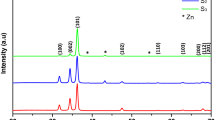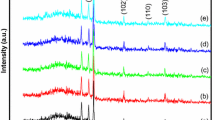Abstract
Zinc oxide (ZnO) nanorods (NRs) were obtained by oxidation of Zn thin layers, prepared by thermal evaporation method under electric field, at different times of 2.5, 5, 7.5 and 10 h. The crystal structure of samples was investigated using X-ray diffraction (XRD) measurement, which showed samples had a wurtzite hexagonal structure. In addition, field emission scanning electron microscopy (FESEM) indicated that with an increase in the oxidation time, the NRs diameter increased too. Elemental analysis of samples was performed using energy-dispersive X-ray spectroscopy (EDX) which clearly confirmed the presence of Zn and O with an atomic ratio of 1:1. Further, Raman spectra of samples verified wurtzite hexagonal phase due to high- and low-frequency vibration of E2 modes at room temperature and showed that with an increase in the oxidation time, the lattice defects decreased whereas crystal quality of samples increased. Optical properties of samples were determined by UV spectroscopy and demonstrated that when the oxidation time was added, the band gap energy of ZnO NRs decreased, which was attributed to the increase in crystallite size.









Similar content being viewed by others
References
I. Wallace et al., Synthesis and characterization of zinc oxide (ZnO) nanowire. J Nanomed Nanotechnol 6(321), 2 (2015)
Y. Tong et al., Growth and optical properties of faceted hexagonal ZnO nanotubes. J. Phys. Chem. B 110(30), 14714–14718 (2006)
C. Dwivedi, V. Dutta, Size controlled synthesis of ZnO nanoparticles via electric field assisted continuous spray pyrolysis (EACoSP) reactor. Appl. Phys. A 109(1), 75–79 (2012)
F. Xue et al., Influence of external electric field on piezotronic effect in ZnO nanowires. Nano Res 8(7), 2390–2399 (2015)
Y. Zhang et al., Synthesis, characterization, and applications of ZnO nanowires. J. Nanomater. 2012, 20 (2012)
C.R. Chandraiahgari et al., Synthesis and characterization of ZnO nanorods with a narrow size distribution. RSC Adv. 5(62), 49861–49870 (2015)
S. Chu et al., Electrically pumped waveguide lasing from ZnO nanowires. Nat. Nanotechnol. 6(8), 506 (2011)
J.H. Na et al., Hybrid p-n junction light-emitting diodes based on sputtered ZnO and organic semiconductors. Appl. Phys. Lett. 95(25), 329 (2009)
P. Sudhagar et al., Facile synthesis of highly branched jacks-like ZnO nanorods and their applications in dye-sensitized solar cells. Mater. Res. Bull. 46(9), 1473–1479 (2011)
Z.L. Wang et al., Lateral nanowire/nanobelt based nanogenerators, piezotronics and piezo-phototronics. Mater. Sci. Eng. 70(3–6), 320–329 (2010)
J. Xu et al., Studies on alcohol sensing mechanism of ZnO based gas sensors. Sens. Actuat. B 132(1), 334–339 (2008)
C.-Y. Lu et al., Ultraviolet photodetectors with ZnO nanowires prepared on ZnO: Ga/glass templates. Appl. Phys. Lett. 89(15), 153101 (2006)
S. Cho et al., Large-scale fabrication of sub-20-nm-diameter ZnO nanorod arrays at room temperature and their photocatalytic activity. J. Phys. Chem. C 113(24), 10452–10458 (2009)
P. Li et al., Investigation on the mechanism of nanodamage and nanofailure for single ZnO nanowires under an electric field. ACS Appl. Mater. Interfaces 6(4), 2344–2349 (2014)
N. Morales-Flores et al., Morphology control and optical properties of ZnO nanostructures grown by ultrasonic synthesis. Adv. Nano Res. 1(1), 59–70 (2013)
Q. Zhou et al., Synthesis of vertically-aligned zinc oxide nanowires and their application as a photocatalyst. Nanomaterials 7(1), 9 (2017)
E.W. Petersen et al., Growth of ZnO nanowires catalyzed by size-dependent melting of Au nanoparticles. Nanotechnology 20(40), 405603 (2009)
G. Wu et al., Controlled synthesis of ZnO nanowires or nanotubes via sol–gel template process. Solid State Commun. 134(7), 485–489 (2005)
G. Jimenez-Cadena et al., Synthesis of different ZnO nanostructures by modified PVD process and potential use for dye-sensitized solar cells. Mater. Chem. Phys. 124(1), 694–698 (2010)
R. García-Gutiérrez et al., Luminescence and structure of ZnO grown by physical vapor deposition. Adv. Mater. Sci. Eng. 2012, 872597 (2012)
O. Fouad et al., Zinc oxide thin films prepared by thermal evaporation deposition and its photocatalytic activity. Appl. Catal. B 62(1–2), 144–149 (2006)
Islam, M., et al. Zinc oxide thin film fabricated by thermal evaporation method for water splitting application. In: 2015 International Conference on Electrical & Electronic Engineering (ICEEE). 2015. IEEE.
M. Faraj, K. Ibrahim, Optical and structural properties of thermally evaporated zinc oxide thin films on polyethylene terephthalate substrates. Int. J. Polym. Sci. 2011, 302843 (2011)
Palimar, S., G. Shivakumar, K.V. Bangera. Conductive and transparent undoped ZnO thin films prepared by thermal evaporation method. In: AIP Conference Proceedings. 2012. AIP.
M. Jouya, F. Taromian, S. Siami, Rapid growth of zinc oxide nanobars in presence of electric field by physical vapor deposition. J. Theor. Appl. Phys. 11(4), 291–299 (2017)
M. Afshari, M. Ghazi, M. Izadifard, Structural and magnetic properties of Fe/Cu/Fe trilayers. Afr. Rev. Phys. 10, 27–37 (2015)
M.H. Amerioun et al., Fabrication of CuInS2/CNTs absorber layers by sol–gel method. Mater. Sci. Semicond. Process. 38, 149–156 (2015)
M. DasariAyodhya et al., Synthesis, characterization of ZnS nanoparticles by coprecipitation method using various capping agents-Photocatalytic activity and Kinetic study. IOSR J. Appl. Chem. 6(1), 01–09 (2013)
S. Terohid et al., Effect of growth time on structural, morphological and electrical properties of tungsten oxide nanowire. Appl. Phys. A 124(8), 567 (2018)
S.N. Alam et al., SEM, EDX & XRD of zinc oxide nanostructures synthesized by zinc oxidation. Microsc. Anal. 26(4), 11–14 (2012)
A.F. Abdulrahman et al., Different substrates effects on the topography and the structure of the ZnO nanorods grown by chemical bath deposition method. Dig. J. Nanomater. Biostruct. 11(3), 1007–1016 (2016)
R. Zhang et al., Photoluminescence and Raman scattering of ZnO nanorods. Solid State Sci. 11(4), 865–869 (2009)
I. Musa, N. Qamhieh, S.T. Mahmoud, Synthesis and length dependent photoluminescence property of zinc oxide nanorods. Results Phys. 7, 3552–3556 (2017)
N. Neykova et al., Study of ZnO nanorods grown under UV irradiation. Appl. Surf. Sci. 472, 105–111 (2019)
Y. Zhang et al., Synthesis, characterization, and applications of ZnO nanowires. J. Nanomater. 2012, 624520 (2012)
Islam, M., et al. Zinc oxide thin film fabricated by thermal evaporation method for water splitting application. In 2015 International Conference on Electrical & Electronic Engineering (ICEEE). 2015. IEEE.
X. Li et al., Fabriction of ZnO nanorods with strong UV absorption and different hydrophobicity on foamed nickel under different hydrothermal conditions. Micromachines 10(3), 164 (2019)
Author information
Authors and Affiliations
Corresponding author
Additional information
Publisher's Note
Springer Nature remains neutral with regard to jurisdictional claims in published maps and institutional affiliations.
Rights and permissions
About this article
Cite this article
Jouya, M., Taromian, F. & Afshari Abolkarlou, M. Growth of Zn thin films based on electric field by thermal evaporation method and effect of oxidation time on physical properties of ZnO nanorods. J Mater Sci: Mater Electron 31, 8680–8689 (2020). https://doi.org/10.1007/s10854-020-03403-w
Received:
Accepted:
Published:
Issue Date:
DOI: https://doi.org/10.1007/s10854-020-03403-w




